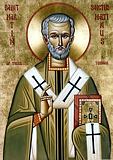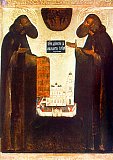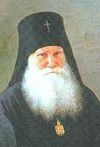

| Previous day | Next day |
| Old Style
October 12
|
Wednesday |
New Style
October 25
|
|
21st Week after Pentecost.
Tone 3.
Fast Day. |
Wine and oil allowed.
|
![]() Martyrs Probus, Tarachus, and Andronicus, at Tarsus in Cilicia (304).
Martyrs Probus, Tarachus, and Andronicus, at Tarsus in Cilicia (304). ![]() St. Cosmas the Hymnographer, bishop of Maiuma (ca. 787).
St. Cosmas the Hymnographer, bishop of Maiuma (ca. 787).
Martyr Domnina of Anazarbus (286). St. Martin the Merciful, bishop of Tours (397). Sts. Amphilochius (1452), Macarius (1480), and Tarasius (1440), abbots, and Theodosius, monk (15th c.), of Glushitsa Monastery (Vologda), disciples of St. Dionysius of Glushitsa. St. Arsenius, archimandrite, of Svyatogorsk Monastery (1859). St. Euphrosyne (Mezenova) the Faster, schema-abbess, of Siberia (1918). Glorification of St. Philaret, archbishop of Chernigov (2009).
New Hieromartyrs Juvenal (Maslovsky), archbishop of Ryazan (1937) and Lawrence (Levchenko), hieromonk, of Optina Monastery (1937). New Hiero-confessor Nicholas (Mogilevsky), metropolitan of Alma-Ata (1955).
“Jerusalem” (48) and “Kaluga” (1748) Icons of the Most Holy Theotokos.
Hieromartyr Maximilian, bishop of Noricum (284). St. Mobhi of Glasnevin (Ireland) (544). Martyr Edwin, king of Northumbria (633). St. Wilfrid, bishop of York (709). Translation of the relics of St. Sabbas the Sanctified from Rome to Jerusalem (1965). Virgin-martyr Anastasia of Rome (ca. 250). St. Theodotus, bishop of Ephesus. St. Jason, bishop of Damascus. St. Symeon the New Theologian [transferred from Great Lent, March 12] (1022). St. Theosebius the God-bearer, of Arsinoe on Cyprus.
Thoughts for Each Day of the Year
According to the Daily Church Readings from the Word of God
By St. Theophan the Recluse

Wednesday. [Col. 1:18-23; Luke 8:22-25]
When they got in the ship to sail to the other side of the lake, did the apostles think that they would meet with a tempest and expose their lives to danger? Meanwhile, a tempest suddenly arose and they did not expect to remain alive. Such is the path of our life! You do not know how or from where misfortune will sweep in, capable of destroying us. Air, water, fire, beasts, man, bird, house, in a word—everything around us could suddenly be transformed into a weapon for our death. From this comes a law: live in such a way that every minute you are ready to meet with death and fearlessly enter into its realm. This minute you are alive, but who knows whether you will be alive the next? Keep yourself according to this thought. Do everything you have to, according to the routines of your life, but in no way forget that you could immediately move to a country from which there is no return. Forgetting this will not postpone the determined hour, and intentional expulsion of this decisive upheaval from your thoughts will not lessen the eternal meaning of what will happen after it. Commit your life and all into the hands of God; spend hour after hour with the thought that each hour is the last. From this the number of empty pleasures will decrease; while at death this deprivation will be immeasurably recompensed with a joy to which there is nothing equal in the joys of life.
Articles
 Martyrs Probus, Tarachus, and Andronicus, at Tarsus in CiliciaThe Martyrs Tarachus, Probus, and Andronicus suffered for Christ in the year 304 at Tarsus in Cilicia. |
 Martyr Domnina of AnazarbusThe Martyr Domnina of Anazarbus lived in the region of Cilicia, and suffered for confessing Christianity. |
 Venerable Amphilochius the Abbot of GlushetsaSaint Amphilochius, Abbot of Glushetsa, already a monk of priestly rank, came from Ustiug to Saint Dionysius of Glushetsa (July 1) in the year 1417. |







